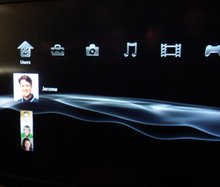Active-TV Ecosystem Developers,
The details of the Apple iTV are not clear; but my conclusion is the announced iTV device is not competitive against an active-TV enabled hybrid-STB.
For some time, there has been debate about Apple introducing a 10'-only, or TV-only, video entertainment device; which would operate in an Extended-PC or Extended-iMac ecosystem. Some other market watchers suggested the next platform would be a hybrid 2/10-foot Mini Mac. Well, the Apple iTV announcement attached below is a disappointment to PC-in-living-room advocates and validation for advocates of the Extended and networked ecosystem approach.
- What competitive pressure is causing Apple to pre-announce the iTV product?
- It seems unlikely Apple feels pressure from Intel ViiV-NMPR or Microsoft-MCE ecosystems, even with Vista's launch and shift to MCML. Further, the continued absence of ViiV clients, may indicate Intel has a clearer future combining a PC with FrontRow clients.
- More interesting is the arrival of the Sony PS3. Maybe Apple FrontRow will not be supported on the PS3, which likely supports a micro-browser approach (CE-HTML, or HTML4CE).
- Could also be, Apple feels pressure from active-TV developments. It is said that a pre-announcement is often used to stall the efforts of competitors.
- Does the box have an ATSC or DVB-t antenna connection?
- The press information makes no mention of video-in connectors or antenna connectors (see pictures below). Without broadcast reception, the iTV is classified as a DMA (Digital Media Adapter), which has a poor history and is now very much out of favor.
- It could be argued that iTV is better optimised for US market constraints, where broadcast TV reception is typically included in a cable STB. Adding DVB-t support for the European market does seem an easier decision.
- The press information makes no mention of video-in connectors or antenna connectors (see pictures below). Without broadcast reception, the iTV is classified as a DMA (Digital Media Adapter), which has a poor history and is now very much out of favor.
- Is there video-in connectors, allowing the box to piggy-back on the video-out connectors of an existing STB?
- Without antenna-in or video-in, there can be no support for overlay-FrontRow (equivalent of active-TV’s overlay-Web-TV). This restricts iTV’s usefulness when supporting new non-linear TV advertising.
- Can FrontRow run standalone on the iTV or does it require projection?
- I suspect the FontRow can run standalone. However, the reporter below indicates “the point of iTV” is to watch movies which have first been downloaded to a PC or iMAC. It could be that the reporter has misunderstood Apple's intentions, or maybe the iTV really has little utility in standalone operation.
- There is no mention of disc support, or integrated NAS; So even if FrontRow is not projected, the iTV may only be usable when the networked Extended-PC is running. The addition of a disc would add to cost, but improve standalone capabilities and wireless video streaming of HD material - I think a disc seems likely.
- Will Apple promote use of FrontRow among TV-web developers?
- One reason for pre-announcing iTV would be building early momentum for FrontRow websites (or web-TV channels). But this was never mentioned during the iTV introduction. However, I would be surprised if Apple limited FrontRow usage to a few Hollywood-content download sites.
- Since the next-generation FrontRow will now be available for a Windows PC, does anything prevent it being projected to an active-TV STB client?
- As with item 5), we don’t know if FrontRow will be promoted as an alternative to MCE spotlights (TV-web). If FrontRow formatted websites appear (leaving DRM aside), then projection would be made easier if FrontRow is processed via the normal PC browser. Not using the existing browser would create more work for Apple and also any alternative projection support.
- What H.264 supporting SOC is used inside the iTV.?
- Possible SOC suppliers are Sigma Design or STM. However a new Intel Xscale device is likely. Intel has less experience with integrating broadcast TV reception technology. Which may indicate why iTV is a DMA and not a STB.
- Again, there are advantages to including an internal disc. This would give the iTV more standalone capability than a DMA typically has. This would also help compensate for using an Intel SOC which does not support broadcast TV reception.
- Will Apple license the middleware supporting FrontRow for use by other STB developers?
- I suggest, for FrontRow to succeed it has to be supported by the majority of the SOC devices used in the STB and CE appliance industry.
- Will the $299 be subsidized by any video service providers?
- The iTV announcement was supported by would-be IPTV movie distributors. They have a difficult business model. The boast has been, IPTV will under-cut other distribution methods, such as video-rental services; this makes it increasingly difficult to subsidize iTV. There has been no indication that the established STB service providers will integrate FrontRow technology.
- Can a $299 price compete against a similarly priced Hybrid-STB supporting DVB-t and active-TV projected TV-web? Both approaches assume the user has a networked PC or iMac.
- The initial iTV price may reflect more concept-pricing than content-pricing, but it does not look inexpensive. However, Apple has not had a flop for many years, and their marketing is renowned.
- I say the iTV, as we understand it from these pre-announcements, is not competitive against an active-TV enabled hybrid-STB.
Feedback, corrections and comments welcome.
more at http://news.com.com/2061-10793_3-6114744.html and http://www.macworld.com/news/2007/01/09/liveupdate/index.php








